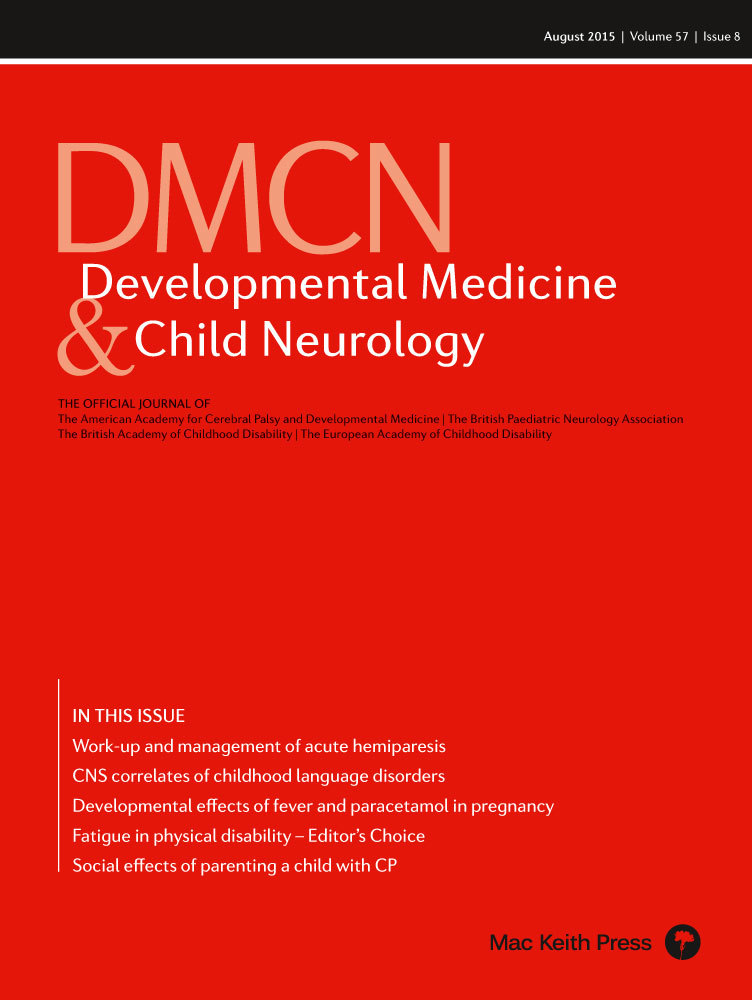Time to take notice: what about fatigue?
Abstract
This commentary is on the original article by Maher et al. on pages 742–747 of this issue.
Fatigue is an excellent gauge of well-being because it is a very hard symptom to mask.
Kathleen A Kendall-Tackett
Healthcare providers address the physical impairments and activity limitations of children with physical disabilities through clinic-based measurements of capacity; however, there are rarely formal, direct assessments of the influence of fatigue on the day-to-day lives of such children. Families frequently report the need to modify activities (e.g. a trip to the zoo or a ball game) and/or use assistive devices (e.g. wheelchairs, etc.) because of physical fatigue, so that a child can participate. Because children and their families selectively manage which activities (physical, emotional, and/or cognitive/academic) they have the ‘reserves’ for each day, relatively sedentary lifestyles can result. Young people with cerebral palsy (CP) often report that they want to be more physically active, but acknowledge pain and fatigue as barriers to participation.1 With regard to cognitive and academic function, pain and fatigue have been documented to partially mediate the relationship between topographical severity and performance at school in children with CP.2 Fatigue is not unique to children; adults with spastic diplegic CP report significantly higher levels of fatigue and pain than unaffected adults.3
Maher et al.4 are the first to describe self-reported fatigue in ambulatory children with physical disabilities, so that comparisons can be made with typically developing children and children with other chronic health conditions. By documenting that fatigue levels in a diverse group of young people with physical disabilities are similar to levels in young people with cancer, this study argues that it is time to pay attention to fatigue in children with physical disabilities, and to address this fatigue directly or indirectly by modifying pain, sleep, or physical activity. Lower levels of mobility participation were associated with higher levels of pain and reduced walking ability in a population-based sample of young people with CP.5 In this paper, self-reported total fatigue was higher in females than in males, and was associated with living in areas of low socio-economic status and with low physical activity, while it was not associated with body weight or functional impairment level. The lack of any relationship between the degree of functional impairment (Gillette Functional Assessment Questionnaire) and self-reported fatigue may be related to the fact that the sample of children included in the study had spent a good deal of their childhood in therapy/adaptive programs designed to enhance their physical function. The discriminative levels of the Gillette Functional Assessment Questionnaire may not be meaningful in the context and relative levels of ‘energy reserves’ available for the activities they chose to participate in, as noted by the authors.
The relationship between lower physical activity and higher levels of total and sleep/rest fatigue has clear clinical implications for targeted interventions. Would regular, formal monitoring of sleep efficiency and physical activity levels positively influence levels of fatigue during childhood? One potential clinical tool for assessing sleep efficiency is the Children's Sleep Habits Questionnaire.6 Scheduled measurements of habitual activity (by accelerometry and questionnaires) throughout childhood may be helpful for identifying the need for any further evaluations and/or to encourage individualized interventions aimed at enhancing activity levels and decreasing fatigue.
Physical activity interventions are recommended as standard of care for other pediatric health conditions (e.g. cancer, diabetes, and obesity). Expanding on the suggestions of the authors, how might the monitoring of fatigue in individuals with disabilities be implemented, within physical training programs or alongside interventions? If real-time levels of fatigue are used to modify an intervention within a training session, the Children's OMNI (Omnibus) Scale of Perceived Exertion7 is an option. To monitor changes in fatigue over a dose of motor training (e.g. treadmill training for 4wks), the PedsQL Multidimensional Fatigue Scale (acute version) 7-day recall has the potential to track fatigue weekly.8 By using such scales within a repeated measures design, the rate of change in exertion/fatigue could be examined relative to changes in primary outcomes.
Future work should examine how pain influences fatigue levels, expanding on the covariates examined by Maher et al.4 It is time to give the influence of fatigue the attention it requires with regard to the care of children with physical disabilities. To paraphrase Terrance Edgar, MD, fatigue is a bit like love: it is internally mediated, but has emotional/physical effects with long-term consequences.




